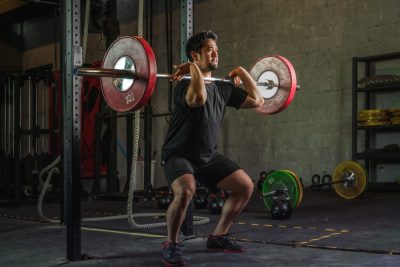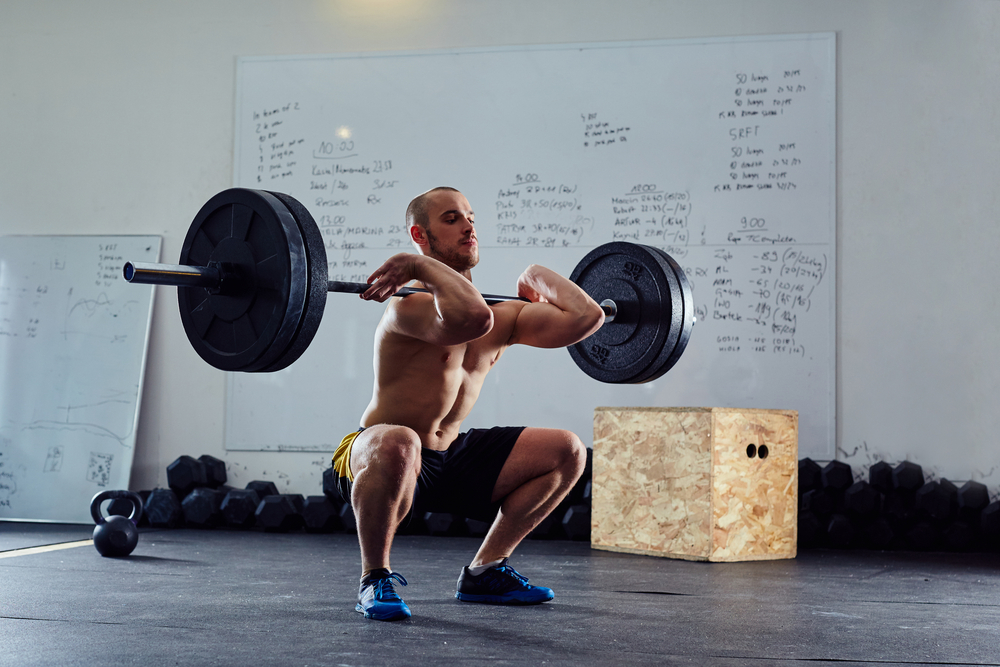If you are looking for an excellent alternative to the normal barbell squat or back squat, you should consider doing front squats.
When it comes to the back squat, you work your hamstrings, quads, glutes, and also call on your lower back and abs to actively stabilize the torso while lifting and lowering the bar. It is, for sure, an efficient exercise for building strength.
However, if you want to increase muscular strength and size, you should add the front squats to your exercise program. It is an underrated exercise that deserves more recognition than it gets.
It has vast similarities with the back squat, and the only major difference is that the bar is held across the front of the shoulders; instead of behind your neck, it is positioned at the top of your chest.
The positional adjustment is one that sees the quads have more responsibility in managing and moving a more significant share of the weight. It also makes your core muscles do more work to balance the upper part of your body and keep your torso upright.
The front squat also comes with an additional benefit that the back squat doesn’t have. You can squat more safely when doing front squats because you mount a position that helps you maintain perfect form and stay upright, unlike the back squat.
Common mistakes when doing front squats
If you are making these mistakes when doing the front squat, you do not have a perfect form;
Pressing the weight against your throat
 While doing the front squat, the bar needs to be placed on the top of your shoulders, with your elbows up and kept in place by your fingers. Might restrict your air passage if you use your fingers to press the bar against your throat or if your elbows go too high.
While doing the front squat, the bar needs to be placed on the top of your shoulders, with your elbows up and kept in place by your fingers. Might restrict your air passage if you use your fingers to press the bar against your throat or if your elbows go too high.
You can seriously injure yourself if you blackout during the front squat because of the weight being pressed against your throat. Immediately lower the weight and drop to one knee if you notice something off about your vision, awareness, or breathing when doing front squats.
Not learning to bail correctly
Lifting heavier things is one step to getting stronger. However, there are times when you fail on the lift when trying to lift heavy things.
Probably the scariest prospect when lifting is finding out that you are going to fail the lift, being trapped under the bar, and not knowing a safe way to get away from the weight.
Bailing properly from the weight is an integral part of lifting that you should learn. Even when using lighter weights, train yourself to fail and bail so that when you actually need to bail from a weight, you will do it properly.
Poor ankle and hip mobility: not squatting deep enough
If you are among those that normally sit in cars or desk chairs all day, you probably have poor ankle and hip mobility. It is a prevalent mistake that people only go down a few inches while doing front squats and think they have completed the movement.
You cheat yourself and only complete a half rep if you don’t squat deep enough that the top of your thighs are parallel. If you want to squat deeper, you can turn your feet out a bit more and take a slightly wider stance.
Poor development of wrist and shoulder flexibility
Another major problem when doing front squats is that some exercisers lack the needed wrist, arm, and shoulder mobility for grabbing the bar correctly with the use of their fingers.
It is possible to do a cross-grip front squat, although it is not advisable to use heavier weights as you cannot safely bail while performing this movement. When doing the front squats, use fewer fingers or grip the bar wider and also ensure that your elbows stay up.
Not staying vertical enough
The front squats can be a tricky movement if you are trying it for the first time. The bar needs to remain over the middle of your feet.
Unlike the back squat, you need to be significantly more vertical; imagine a line was drawn from the bar to the floor, that line should bisect your feet. While doing front squats, most people tend to bend forward, and this could cause problems.
How to do the front squat
This is how to maintain perfect form and perform the front squat properly;
- The bar should be secured in the squat rack before you start and also at mid-chest level.
- With both hands, grab the bar a little bit wider than the distance between your shoulders.
- Mover closer to the bar and enter a quarter squat position so that the bar touches the front of your shoulders and the top of your chest. Take your elbows forward and as high up as possible while still holding the bar. Ensure that your elbows stay high all through as this helps to keep the bar secure in the crook of your hands and resting against your shoulders and chest. It also keeps your body upright.
- Take the bar out of the rack by driving up.
- Take a step back and keep your feet in a distance of the width of your shoulders and ensure that your toes point a little diagonally away from themselves.
- Keep your torso strong by inhaling deeply to fill your chest, brace yourself, and then lower into the squat by bending your legs. Ensure that your heels are down and your knees are wide apart.
- Keep lowering until your legs become parallel with the ground, then revert to the initial position by driving up. That is the perfect form, and you have completed one rep.
Variations of the front squat
Band-resisted front squat
You can add a resistance band to the exercise if you feel like it is not enough, just lifting the weight on the bar. In addition to increasing the resistance of the lift, it also loads the resistance at the top of the move, which is where the tension peaks in the band.
What this means is that there is no additional load towards the lower end of this movement, and it could be a risk because of the mobility challenge. However, it increases your power and forces you to counter the band’s increasing resistance by driving all the way up.
If you want to do this version of the exercise, you fasten the resistance band to a racked bar and ensure that both loops are kept in a slightly broader distance than shoulder-width.
Next, you stand on the band. Then, you do the front squat like you normally would, while ensuring that you keep your form and not be thrown off by the additional resistance.
Offset kettle bell front squat
This variation is one that generally works your core. The highlight of this variation is adding more load to one side of your body so that while squatting, your core works harder to resist the urge to turn to the loaded side, which will involve more muscles than the ones enlisted for a normal up-and-down squat.
This variation of the front squat can either be performed with two kettle bells of different weights or just one. Grab the kettle bell and hold it in the rack against your shoulder, then lower into the squat.
When your elbow passes the inside of the thigh, you can drive up, making sure that all rotations in your torso are resisted.
Goblet squat
If you don’t feel confident about using a loaded barbell for front squats, you can start with a dumbbell or kettle bell until you have mastered the movement. Keep your arms bent and ensure your hands are above your elbows while you hold the weight against your chest.
Keep lowering deeper into the squat until your elbows make contact with the inside of your knees before reverting to the initial position by driving up. This variation strengthens your legs and makes you accustomed to holding a weight in front of you while squatting.
Elevated heels front squat
When doing any type of squat, it can be challenging if you don’t have proper calf flexibility and ankle mobility.
You can use weight plates to elevate your heels while doing the front squats, as you are still working on improving your mobility and flexibility. This will better work your quads and allow you to go deeper.
Front squat form tips
 Elbows
Elbows
The weight will tip forward is you allow your elbows to drop, which will see you lose balance and thereby end that set. You can correct this by actively trying to push your elbows to the ceiling while doing the squats.
It would be best if you also focused on bringing your hands either further apart or close together to see which position allows your elbow to go higher.
Hand position
If you are not used to the front squats, it might be challenging to maintain a perfect for because of the limited flexibility of the forearms and wrists. To fix this, warm your wrists up first and then interlock your fingers and twists your wrists two ways for some minutes.



